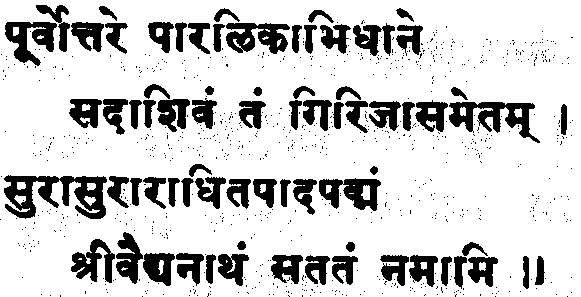This shrine represents one of the 12 Jyotirlingams of Shiva held in reverence
throughout the country. Vaidyanath is located at Deogarh in the Santal Parganas region of
Bihar.

The twelve Jyotirlingas of
Shiva are Somnath in Gujarat, Bhimeshwar, Grushneshwar, Nageshwar and Triyambakeshwar
in Maharashtra, Vaidyanath in Deogarh (or in Parali in Andhra Pradesh), Sree Sailam in
Andhra Pradesh, Rameswaram in Tamilnadu, Benares in Uttar Pradesh, Ujjain and Omkareshwar
in Madhya Pradesh and Kedarnath in the Himalayas.
Deogarh is also known as Vaidyanath,
Haritaki Vana, Ketaki Vana, Ravana Vana, Chitabhoomi and Hardapeetha. Some schools of
thought believe Vaidyanath near Parali in Andhra Pradesh
to be the Vaidyanatha Jyotirlingam. Other schools of thought claim that Kiragram in Punjab
and Dabhoi in Gujarat are the Vaidyanatha Jyotirlinga temples. The Vaideeswaran Koyil temple in Tamilnadu (which is not a
Jyotirlingam temple) enshrines Vaidyanathar.
Legend has it that Ravana
meditated upon Shiva, and requested him to come over to Sri Lanka, in order that his
capital may become invincible. It is said that he attempted to lift Mount Kailash and take it with him to his
capital; however Shiva crushed him with his finger, and Ravana prayed to him and sought
his mercy, after which Shiva gave him one of the twelve Jyotirlingams
with the condition that if it was placed on the ground it would take root immediately.
Ravana carried the Jyotirlingam and began his trek
back to his capital. Varuna the God of water, entered his belly, and
caused him to feel the need to relieve himself. Vishnu then came down in the form of a lad
and volunteered to hold the Jyotirlingam as he relieved himself. Before Ravana returned,
Vishnu placed the Jyotirlingam on the ground, and it became rooted to the spot. A
disappointed Ravana offered severe penances to Shiva here, and cut off nine of his heads.
Shiva revived him and joined the heads to the body, as if by the work of a Vaidya
or a physician, hence this Jyotirlingam goes by the name Vaidyanath. The same legend holds
at Gokarnam in Karnataka.
Another legend has it that this temple was
re-discovered by a cowherd Baiju, and hence the name Baijnath.
Vaidyanath is also considered to be one of the 52 Shakti
Pitha shrines of Sati. It is believed that the heart of Sati fell here, when her
half burnt body being carried by Shiva at the end of Daksha's yagna, was chopped to pieces by Vishnu's
discus.
The temple: The temple is situated in
a spacious courtyard bounded by stone walls. In the temple complex are twenty two other
temples. The Baijnath or Vaidyanath temple faces east. The top of the Shiva Lingam is
slightly broken, keeping with the legend that it chipped away when Ravana tried to uproot
it. Near the temple is the Sivaganga lake. The Chandrakoopa well, near the main entrance
is said to have been built and consecrated with water from several thirthams by Ravana.

